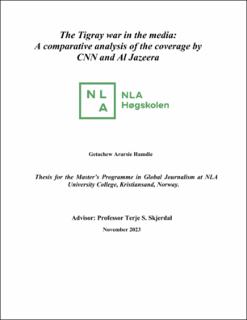| dc.description.abstract | The conflict in Northern Ethiopia provides a compelling case study on how news organisations frame and report complex and contentious issues. This study focuses on the coverage of the Tigray war on CNN and the Al Jazeera English news websites, examining how the two international media outlets covered the conflict. To conduct this comparative study, the data were collected systematically from a set of texts that were published on the two selected news websites during the two-year conflict between the Ethiopian government and the Tigray regional administration (November 4, 2020-to November 4, 2022), and then analysed quantitatively and qualitatively.
A total of 99 news articles from CNN’s website and 268 reports from Al Jazeera’s website were collected and analyzed. Al Jazeera English and CNN provided distinct and contrasting coverage of the conflict. In terms of the number of articles published throughout the two years, the two media outlets show significant differences with Al Jazeera English having many more published news stories than CNN. Despite Al Jazeera giving more impartial and equitable coverage than CNN, neither of the media outlets provided unbiased and independent news coverage. Their reporting favoured the Tigray People's Liberation Front (TPLF). Both media had a significant portion of stories in favour of TPLF. Al Jazeera was found to publish relatively more neutral news stories than CNN and had more mixed news stories.
Both media outlets appeared to rely heavily on conflict and violent framing, which is not surprising given the conflict's multifaceted and protracted nature. While both media outlets applied attribution of responsibility framing, economic framing, and human interest framing. Al Jazeera English was found to use them more frequently. CNN applied prognostic framing more frequently than Al Jazeera, emphasising potential outcomes and solutions. Al Jazeera on its part used diagnostic framing more frequently, emphasising the root causes of the conflict. Overall, anti-war framing was less used, although Al Jazeera was found to use it slightly more than CNN. The study also found that both media outlets treated various themes in a strikingly similar fashion. Human rights issues, disasters, and humanitarian crises appeared to take precedence over other topics such as bilateral and international relations, reconciliation, agriculture, culture and history.
Though they have differences, both media outlets tended to elicit public sympathy and outrage by giving emotional details and personal stories, as well as statistics on the numbers of people affected by famine, displacement, and fear of war.
Keywords: CNN, Al Jazeera, Tigray war, framing, agenda setting, global media, conflict | en_US |
